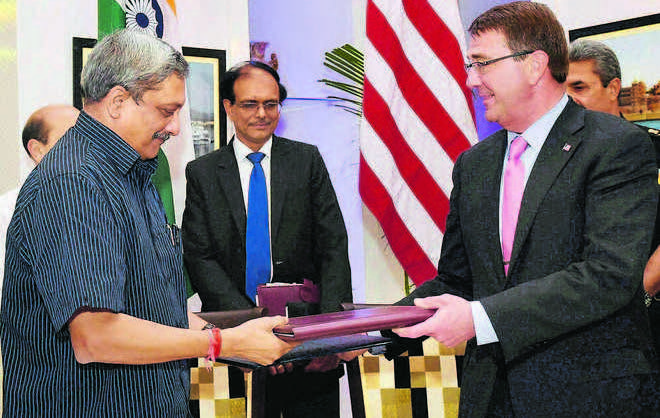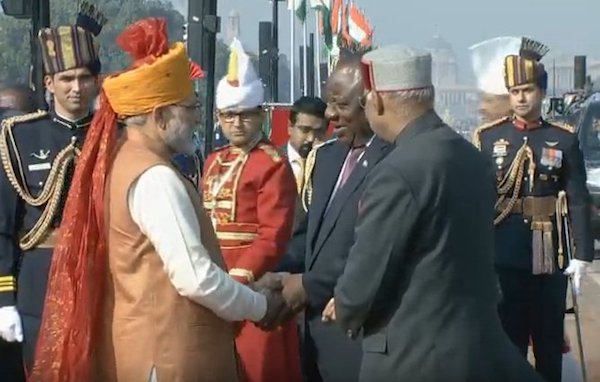
During his recent visit to the US, Defence Minister Manohar Parrikar signed the LEMOA with his American counterpart, Ashton Carter. The memorandum outlined a framework for the provision of supplies like food, fuel and berthing for visiting naval ships and on overflight and landing facilities for military aircraft. The opposition Congress and the Left cried “foul” and accused the government of mortgaging the country’s sovereignty, the country’s policy of “non-alignment”, and even its “strategic autonomy”. This, despite the fact that the agreement contained provisions for providing such facilities, only on a case-by-case basis.
The present agreement logically follows the remarkable transformation in India-US relations, during the presidency of George Bush, by the actions of the two UPA government stalwarts – Prime Minister Manmohan Singh and Mr. Pranab Mukherjee. It was Mr. Mukherjee, as defence minister, who signed a 10-year agreement in June 2005, titled “New Framework for the US India Defence Relationship (NDFR)”, with his American counterpart, Donald Rumsfeld. This framework covered a wide range of activities, including collaboration in multinational operations, when such operations were found to be in “their common interest”. Such cooperation was envisaged in areas like terrorism and curbing nuclear weapons proliferation. There has been a substantial increase in military-to-military cooperation, arms acquisitions and joint exercises between the two militaries, since then. Negotiations, thereafter, continued for signing three framework agreements in defense cooperation, logistics, communications and information security and geospatial information.
The most path breaking agreement that India has signed in this century came barely a month later, when PM Manmohan Singh and President Bush agreed that the US would end nuclear sanctions against India. They also agreed to persuade other nuclear suppliers to end global nuclear sanctions imposed on India after its nuclear test in 1974, by the establishment of the Nuclear Suppliers Group. President Bush stood by his word and even personally intervened with then Chinese President Hu Jintao to fall in line. In the meantime, in August 2008, Mr. Mukherjee, then external affairs minister, signed an agreement with his counterpart, Condoleezza Rice, for the resumption of bilateral nuclear cooperation. The question, which remains, is whether India historically ever provided facilities for positioning foreign warships and aircraft on its soil?
India has historically shaped its military cooperation with foreign powers, from the days of its first PM, Jawaharlal Nehru, based on geopolitical realities, and not ideology. Even before the Sino-Indian border conflict broke out in 1962, the CIA was permitted to position facilities along the border with China, to monitor Chinese nuclear tests. Panicking after the humiliation heaped on India in the 1962 conflict, a desperate Nehru wrote to President Kennedy, appealing him to deploy 12 squadrons of fighters and two squadrons of fighter bombers, together with radar cover, on Indian soil. The US was permitted to use a staging base in Charbatia, Odisha, for flying its U2 spy planes over China. Strangely, our non-alignment was such in the 1950s that we fought shy of seeking defense equipment from the Soviet Union, despite signs of a growing Sino-Soviet rift!
In less than a decade, thereafter, the geopolitical situation turned upside down, with Nixon and Mao embarking on a clandestine love affair, midwifed by Pakistan. This “love affair” came to light when Henry Kissinger flew secretly to China from Pakistan. Indira Gandhi had no hesitation in entering into a defense agreement with the Soviet Union to deal with the emerging US-China-Pakistan axis. The Soviet Union had proposed a bilateral treaty with India in 1969, when its defense minister Marshal Grechko visited India. The draft treaty proposed by the Soviets gathered dust for two years in South Block. It was spruced up once it became clear that a Sino-US-Pakistan axis was emerging to counter the Soviet Union and, incidentally, India also, even as the Pakistan army proceeded with its genocide in Bangladesh.
Once this geopolitical reality was recognized in Moscow and New Delhi, DP Dhar was sent to Moscow to finalize the treaty in the first week of August 1971. Sardar Swaran Singh and Andrei Gromyko signed the treaty on August 21, 1971. Despite our claims of being “non-aligned”, there was a clear military provision in Article 9 of the Indo-Soviet Treaty. It read: “In the event of either party (India and the Soviet Union) being subjected to an attack or a threat thereof, the High Contracting Parties shall immediately enter into mutual consultations, in order to remove the threat and to take appropriate effective measures, to ensure peace and security of their countries.” I was then a young First Secretary in Moscow and took notes in meetings as events unfolded. When the conflict broke out in December 1971, the Soviets, though isolated, vetoed every effort by the US-China axis to stop us from liberating Bangladesh. According to what the Soviets told us, they had deployed mechanized forces and airpower on their borders with China and warned China of serious consequences if it militarily intervened. A Russian nuclear submarine followed the USS Enterprise, as it crossed the Straits of Malacca.
The world situation has changed drastically since the 1970s. What has, however, continued, is the Sino-Pakistan axis, with a growingly powerful China providing Pakistan with nuclear weapons and ballistic missile capabilities, while enhancing Pakistan’s maritime, air and land power. The China-Pakistan Economic Corridor is being accompanied with the establishment of a direct fiber optic link between the headquarters of the Western Theatre Command of China’s People’s Liberation Army in Kashgar (in China’s Muslim-majority Xinjiang province) and the GHQ of the Pakistan army in Rawalpindi.
Signing defense cooperation agreements with the US does not mean we are compromising our “strategic autonomy”. We will continue to differ with the US on some of its policies; in Syria and elsewhere. We should understand Russian imperatives in its immediate neighborhood, in Crimea and elsewhere, while strengthening defense and energy cooperation with Moscow. We should spare no effort to enhance mutual trust and confidence in the India-Russia relationship.
In the meantime, both India and China hopefully share a common interest in maintaining peace and tranquility along their borders. The 2005 agreement outlining the guidelines for a settlement of the border issue remains the most viable framework for moving forward.
(The author is a career diplomat and author)




Be the first to comment